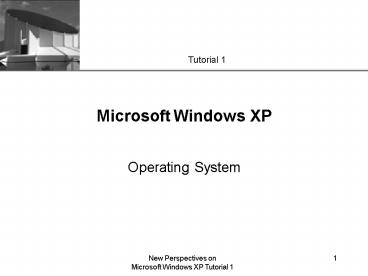New Perspectives on Microsoft Windows XP Tutorial 1 - PowerPoint PPT Presentation
1 / 28
Title:
New Perspectives on Microsoft Windows XP Tutorial 1
Description:
The Windows XP desktop uses a graphical user interface (GUI), which displays icons ... Windows XP Taskbar and Toolbars. You should always close a program when ... – PowerPoint PPT presentation
Number of Views:177
Avg rating:3.0/5.0
Title: New Perspectives on Microsoft Windows XP Tutorial 1
1
Microsoft Windows XP
Tutorial 1
- Operating System
2
Starting Windows XP
- Windows XP automatically starts when you turn on
your computer - You might be asked to enter your username and
password - The Windows XP desktop uses a graphical user
interface (GUI), which displays icons
3
The Windows XP Desktop
4
Elements of the Windows XP Desktop
5
Using a Pointing Device
6
Using a Pointing Device
- Positioning the pointer over a specific part of
the screen is called pointing - Clicking refers to pressing a mouse button and
immediately releasing it - Double-clicking
- Select an object by pointing to it and then
clicking it - Clicking an object with the right button is
called right-clicking - Right-clicking both selects an object and opens
its shortcut menu
7
Starting a Program
- Click the Start button on the taskbar, and then
point to All Programs - If necessary, point to the submenu option that
contains your program - Click the name of the program you want to start
8
Starting a Program
9
Running Multiple Programs
- Multitasking allows you to work on more than one
project at a time and switch quickly between
projects
10
Windows XP Taskbar and Toolbars
- The easiest way to switch between programs is to
use the program buttons on the taskbar - The taskbar also can contain toolbars, which are
sets of buttons giving the user single-click
access to programs or documents that arent
running or open - The Quick Launch toolbar gives quick access to
Internet programs and to the desktop
11
Windows XP Taskbar and Toolbars
- You should always close a program when you finish
using it - You can close a program by using the shortcut
menu associated with the program button on the
taskbar
12
Shutting Down Windows XP
- You should always shut down Windows XP before you
turn off your computer - The Log Off option on the Start menu logs you off
of Windows XP but leaves the computer on - To shut down Windows XP
- Click the Start button
- Click Turn Off Computer
- Click the Turn Off button
13
Anatomy of a Window
- A window is a rectangular area of the screen that
contains a program, text, graphics, or data - Window controls
14
Anatomy of a Window
15
Manipulating a Window
- The Minimize button hides a window so that only
the program button on the taskbar remains visible - You can redisplay a minimized window by clicking
the programs button on the taskbar - The Maximize button enlarges a window so that it
fills the entire screen
16
Manipulating a Window
- The Restore button reduces the window so that it
is smaller than the entire screen - You can use the mouse to move a window to a new
position on the screen - Dragging
- You can use the mouse to change the size of a
window with the sizing handle
17
Using Program Menus
- Most Windows programs use menus to organize the
programs features and available functions - When you click any menu name, menu items or
commands for that menu appear below the menu bar - Menu conventions
18
Examples of Menu Conventions
19
Using List Boxes and Scroll Bars
- A list box displays a list of available choices
from which you can select - A list arrow allows you to view more options in a
list box - Buttons also have list arrows, indicating that
there is more than one option for that button
20
Using Dialog Box Controls
- Some dialog boxes group different kinds of
information into bordered rectangular areas
called panes - Description of dialog box controls
21
Using Dialog Box Controls
22
Using Help
- Windows XP Help provides on-screen information
about the program you are using - To start Windows XP Help, click the Start button
on the taskbar, and then click Help and Support
23
The Help and Support Center Window
24
The Help and Support Center Window
- The Home page lists common tasks under the
heading Pick a Help topic in the left pane on
the page - The Index page displays an alphabetical list of
all the Help topics - The Favorites page shows Help topics youve added
to your Favorites list - The History page lists links youve recently
selected for Help
25
The Help and Support Center Window
- The Support page includes links that you can
click to connect to the Microsoft Web site for
additional assistance - The Options page provides ways you can customize
help - You can use the Search box to search for all
keywords contained in the Help pages
26
Finding a Help Topic on the Home Page
27
Using the Index to Locate Information
28
Using Search to Find a Help Page































